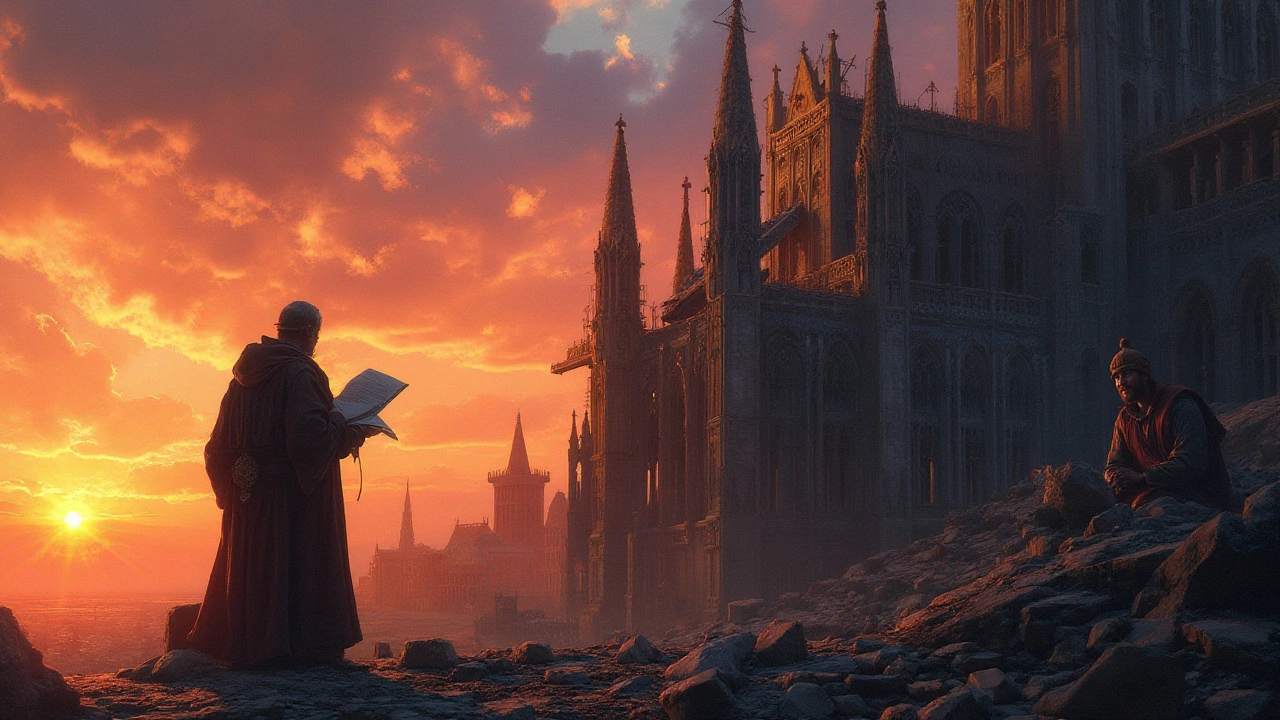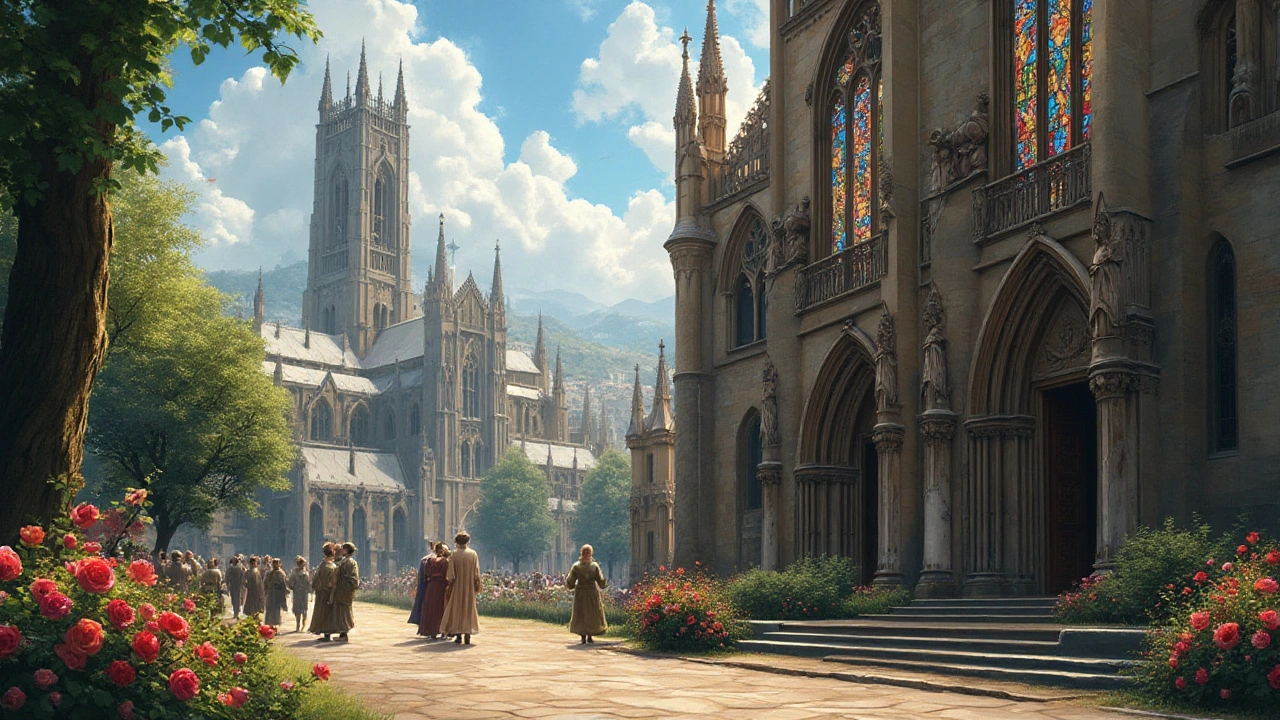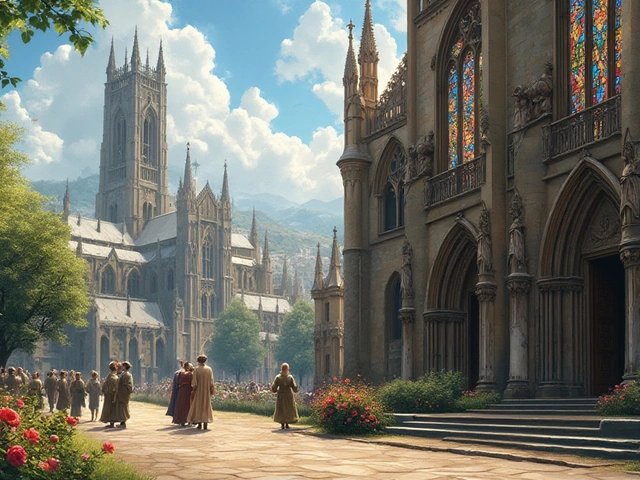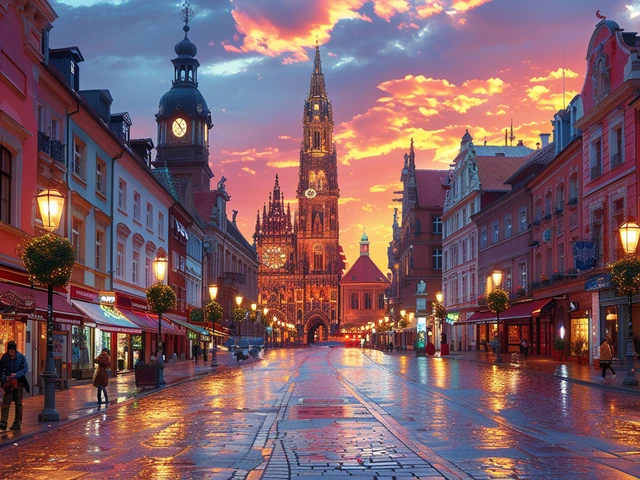Gothic architecture is a stunning ode to human ingenuity and spiritual yearning from a bygone era. It transformed Europe's landscape, introducing awe-inspiring structures that seemed to reach towards the heavens. This architectural style flourished during the High and Late Middle Ages and remains celebrated for its revolutionary techniques and profound symbolic meanings.
Originating in France in the 12th century, Gothic architecture quickly spread across Europe, influencing countless churches and cathedrals. At its core, it was more than just a style; it was a representation of the medieval mind's quest for connecting with the divine. With its signature pointed arches, ribbed vaults, and flying buttresses, Gothic design was as much about innovation as it was about invoking reverence.
Cathedrals like Notre-Dame de Paris and Chartres Cathedral are not just buildings; they are narratives carved in stone and glass. The intricate designs and stained-glass windows were meant to communicate biblical stories and inspire the viewer's faith. Each element, from the towering spires to the gargoyles watching from above, served a distinct purpose, weaving together the physical and spiritual worlds.
- The Origins of Gothic Architecture
- Key Features and Techniques
- Iconic Gothic Cathedrals
- Gothic Architecture's Symbolism
- The Legacy and Influence of Gothic Design
The Origins of Gothic Architecture
The roots of Gothic architecture can be traced back to the heart of France, specifically in the Île-de-France region during the 12th century. It emerged like a blossom from the Romanesque style, which was prevalent across Europe at the time. The Abbey of Saint-Denis, near Paris, is often heralded as the birthplace of the Gothic style. The abbey was renovated under the direction of Abbot Suger, who aimed to create a space filled with light, which he believed was a reflection of the divine. The innovative use of ribbed vaults and pointed arches in the abbey's construction marked a pivotal shift in architectural design.
This architectural transformation wasn't merely aesthetic. It echoed the societal changes swirling through medieval Europe—a period marked by religious fervor and a growing intellectual movement. As towns expanded and wealth increased, there was a strong desire among communities to build larger, more awe-inspiring places of worship that conveyed the glory of God. This was a time when the Church held immense power and influence. Building grand cathedrals became a way to express both civic pride and devotion. Changes in building techniques paralleled developments in philosophy and theology, as medieval scholars, such as Thomas Aquinas, explored the connection between faith and reason.
The pointed arch, a distinguishing feature of Gothic architecture, allowed for more stability and the creation of expansive windows compared to the thicker walls required by Romanesque structures. This engineering advancement also introduced the possibility of intricate stained-glass windows, permitting light to cascade in vibrant hues across the stone floors, further enhancing the spiritual atmosphere within. The design culminated in an upward thrust towards the heavens, a symbolic journey towards the divine aspiration. It created an environment where liturgical and civic gatherings could take place under a breathtaking canopy of stone and glass.
"Gothic architecture's magnificence lies not only in its awe-inspiring verticality but also in the luminous atmosphere it creates," writes historian Paul Frankl, emphasizing the transformative power these structures had on medieval communities.
Another pivotal innovation was the flying buttress, a semi-detached support that enabled builders to construct taller structures with enormous, open spaces inside. This design was not just an architectural solution but a symbol of the era's extraordinary ambition and technical progress. The precise alignment of stones, the meticulous planning of weight distribution, and the embodiment of spiritual ideals in stone were unparalleled. Through these techniques, architects and builders could rise beyond the limitations of previous styles, setting the stage for masterpieces in ecclesiastical construction.
Evolution and Spread
With the success of Gothic architecture in France, the style rapidly spread to other parts of Europe. Each region added its own local variations to suit cultural contexts and materials available. In England, for instance, the Gothic style leaned towards horizontal lines, culminating in what's known as the English Gothic. Meanwhile, Germany developed its own form referred to as Brick Gothic, highlighted by a reliance on red brick due to the scarcity of stone. Italy, too, adapted the style yet often retained elements of classical architecture, resulting in structures that blended Gothic elements with Italian innovations.
The movement was not confined to religious edifices alone. As the Gothic style evolved, it carved its way into civic buildings, universities, and castles. Despite the differences in application and adaptation, these structures commonly reinforced the idea of reaching towards a divine ideal, expressing an architectural language that resonated deeply with those living through the profound transitions of the Middle Ages.
Key Features and Techniques
When we stroll through the magnificent halls of a Gothic cathedral, there's plenty that catches the eye: the striking verticality, the intricate stone carvings, the enigmatic play of light streaming through vibrant stained-glass windows. But what makes these marvels of Gothic architecture stand out? The genius lies in both their unique features and the ingenious techniques employed during their creation. Key among these features is the pointed arch, a defining element that enabled these structures to astound aesthetically while supporting substantial structural loads. This cleverly modified archway helped to evenly spread the weight of the magnificent roofs, setting a new standard for architectural design.
Another noteworthy innovation is the ribbed vault, which brought new flexibility, strength, and elegance to cathedral ceilings. By interlocking crossed arches forming a rib-like skeleton, builders could create a ceiling more graceful and complex than the earlier barrel vaults, transforming interior vistas into mesmerizing caverns of light and shadow. This technique not only enhanced durability but also allowed for vast expanses that could be ornately decorated, adding to the spiritual experience the architecture sought to evoke.
“The Gothic cathedral was a microcosm: it represented an image of the world, aspiring to design, in its great elevation, an image of heaven. The geometries reflected the order of the universe and the belief in a divine, mathematical creator.” — Source on medieval architectural theory
No discussion of Gothic structures is complete without mentioning the flying buttress, an external architectural feature that allowed these buildings to reach unprecedented heights. These semi-detached supports counterbalanced the forces pushing the walls outward, artfully solving a crucial engineering challenge. Not simply a functional appendage, the graceful arc of each buttress complemented the architectural aesthetic. Without the advent of the flying buttress, the towering spires that pierce the clouds today might still have been constrained by earthly limits.
Considering the artistic grandeur, stained glass windows are another hallmark of the era. Crafted with precision and a deep understanding of biblical tales, these windows turned light into a symbol of spiritual enlightenment. Each colorful pane depicted scenes designed to educate and inspire worshippers, casting ethereal hues across the interiors. These windows were not merely decorative but served didactic purposes during a time when literacy was a privilege, making sacred stories accessible to the broader public.
Innovative Techniques in Gothic Construction
The meticulous craftsmanship of stonemasons played a central role in bringing these majestic sites to life. Precision cutting and careful carving of stones ensured that each block fit seamlessly, providing the strength and stability necessary for the towering heights of the edifice. Builders employed ingenious lifting devices and scaffolding systems that were ahead of their time, echoing a remarkable understanding of geometry and physics.
In some Gothic cathedrals, construction spanned several lifetimes. With advances in techniques and tools, new generations of architects and craftsmen could not only sustain but also enhance the work of their predecessors, leading to a unique blend of styles and a rich tapestry of design evolution over centuries. This cumulative knowledge enshrines Gothic architecture as a testament to medieval spirituality and the human quest for reaching beyond, both in form and idea, a reminder of our ongoing journey to understand and express the infinite.
Iconic Gothic Cathedrals
The grandeur of Gothic architecture can best be appreciated by exploring the monumental cathedrals that dot the European landscape. These structures are feats of engineering and devotion, each showcasing distinct local variations while maintaining the unmistakable elements of the Gothic style. Among the most famous is the Notre-Dame de Paris, whose construction began in 1163 and took nearly two centuries to complete. Its iconic towers and rose windows attract millions of visitors each year, despite the tragic fire in 2019 that threatened its storied legacy. This cathedral has long been a beacon of Parisian Gothic architecture, embodying the spirit of the High Middle Ages with its elaborate façade and stone carvings that include scenes from the Bible and secular life.
Equally captivating is the Chartres Cathedral, located about 80 kilometers southwest of Paris. This cathedral is renowned for its remarkable stained glass windows, which have survived in excellent condition for centuries. The blues of Chartres' windows are particularly famous, creating a mesmerizing effect of colored light filtering through the interior. The cathedral also houses an impressive labyrinth inlaid into the floor, which has been walked by countless pilgrims seeking reflection and connection to the sacred. A notable feature of Chartres is its asymmetrical spires, each built in a different style, symbolizing the evolution of Gothic architecture over time.
In England, the Canterbury Cathedral is a prominent example, serving as a testament to medieval spirituality and the spread of Gothic influence across Europe. Founded in 597 and reconstructed in the Gothic style starting in the 12th century, it is an important ecclesiastical site and a popular pilgrimage destination. The cathedral is deeply entwined with the history of the church in England, most notably as the site of the murder of Archbishop Thomas Becket in 1170. This event propelled Canterbury into the spiritual spotlight, making it a place of profound religious significance.
The Kölner Dom, or Cologne Cathedral in Germany, stands as a masterpiece of European Gothic architecture. This towering structure stretches towards the sky, with twin spires reaching over 150 meters, making it one of the tallest cathedrals in the world. It was started in 1248 but wasn't completed until 1880, reflecting a long-term dedication that spans centuries. Inside, the cathedral boasts an incredible collection of sacred art, including the Shrine of the Three Kings, said to contain the relics of the Magi. Cologne Cathedral's deep historical and religious roots make it a prominent landmark on the European continent and a symbol of faith enduring through time.
Across the channel, Milan Cathedral (Duomo di Milano) showcases how the Gothic design could be adapted over time. While construction commenced in 1386, it was not officially completed until the 20th century, reflecting both the continuity and evolution of artistic ambition. The cathedral's exterior is a forest of spires and statues, comprising over 3,000 sculptural figures and intricate marble detailing that dominate the Milan skyline. Its interior is a vast space bathed in light that filters through expansive stained glass windows, serving both spiritual and aesthetic purposes. These elements collectively emphasize the balance of beauty and function, a hallmark of Gothic art and architecture.
Gothic Architecture's Symbolism
When exploring Gothic architecture, one cannot overlook the profound symbolism that is thoughtfully integrated into every element of its design. The architects of the Gothic period were not merely builders; they were storytellers, weaving narratives through stone and glass that would educate, awe, and inspire. At the heart of this style is the idea of transcending the earthly realm, seeking a divine connection. This aspiration is vividly expressed through the upward progression of structures. The towering spires and pointed arches were not only a feat of engineering prowess but also an expression of reaching for the heavens, symbolizing human aspiration and devotion to God.
The stained glass windows, a hallmark of Gothic cathedrals, play a significant role in conveying biblical tales and moral lessons. Artisans crafted these windows with meticulous precision, using vivid colors to create luminous stories. These weren’t mere decorations; they were didactic tools for an illiterate population, enabling them to grasp complex spiritual narratives. A single piece of glass, in its multifaceted hues, could encapsulate an entire story, turning light itself into a medium of divine revelation. In places like Chartres Cathedral, the famed Blue Virgin window beautifully depicts the life of Mary, blending artistry with the sacred.
Walking through a Gothic cathedral, one might notice the presence of grotesques and gargoyles. These intriguing features serve a dual purpose: practical and symbolic. Practically, they function as ornate water spouts, redirecting rain away from the stone. Symbolically, however, they are said to ward off evil spirits, serving as the medieval imagination’s embodiment of the chaotic forces that lie outside the sanctity of the church. This juxtaposition of the sacred and the monstrous speaks to a deeper spiritual awareness—the ever-present battle between good and evil.
In addition, many Gothic structures adhere to numerological symbolism, echoing the divine order. For example, numbers like three, which is often associated with the Holy Trinity, appear frequently in the architectural elements and design. Whether it be through three-part window tracery or the tripartite arrangements in facades, each numerical choice resonates with spiritual meaning. This symbolic harmony can be seen as a reflection of the age's theological beliefs, where every detail speaks to a broader cosmic order.
"Gothic architecture, in all its drama and beauty, is an expression of spirituality that seeks neither to hide nor to alter but to transport." – Camille Enlart, art historian
Through its symbolic richness, Gothic architecture offers insights not only into the technical achievements of the medieval era but also into the metaphysical quests that defined an age. It is a dialog with eternity, an invitation to the viewer to ponder the deeper mysteries of existence. By capturing the interplay of shadows and light, earthly and divine, Gothic architecture remains a timeless testament to the human spirit’s quest for meaning and connection with the divine. The importance of this symbolic architecture continues to inspire scholars, artists, and the faithful, century after century, inviting new generations to interpret its eternal stories.

The Legacy and Influence of Gothic Design
Gothic architecture, with its flowing lines and towering structures, left an indelible mark on architectural history. The impact of this majestic style extends beyond its immediate period, rippling through time to inspire countless modern movements and architects. Prominent for its dramatic play of light within spaces and the audacious attempts to reach new structural heights, Gothic architecture became a catalyst for architectural innovation, setting the stage for future developments. Styles like neo-Gothic in the 19th century, saw architects like Auguste Pugin in England and Eugène Viollet-le-Duc in France revive Gothic elements, celebrating its grandeur while adapting it to contemporary needs. The renewed interest in Gothic design during this period was, in part, a reaction to the industrial age's emphasis on functionality over aesthetics, indicating a desire to reconnect with the meaning and artistry that characterized medieval spirituality.
Architects and designers have consistently sought inspiration from the rich tapestry of forms and techniques characteristic of the Gothic period. The integration of pointed arches and ribbed vaults transcended purely religious buildings, finding their way into civic architecture, such as universities and palaces worldwide. The visual storytelling inherent in Gothic architecture – with its expressive sculptures and vibrant stained glass – continues to captivate modern audiences, amplifying its timeless appeal. The ingenuity of the flying buttress, a functional yet elegant solution to structural demands, serves as a study in how architectural needs can be met with artistic finesse. Today, Gothic architectural features enrich the fabric of cities globally, from New York's St. Patrick's Cathedral to the Washington National Cathedral, positioning these modern incarnations as beloved landmarks rooted in medieval tradition.
"Gothic architecture represents a bold leap into light and space, a testament to human aspirations." – Simon Jenkins, author and architectural historian.
The Lasting Cultural Appeal
Beyond the bricks and mortar, the enduring legacy of Gothic design exists in its cultural resonance and symbolic potency. In literature, art, and even fashion, the elements of Gothic aesthetic continue to evoke a sense of mystery and intrigue. Authors like Horace Walpole and Mary Shelley employed Gothic motifs to evoke an atmosphere of suspense and adventure, anchoring their works in a canvas painted by high ceilings and shadowed corners. Gothic art, especially through the lens of the Pre-Raphaelites, sought to revive an art form long lost to modernity's drab realities. Such an enduring fascination speaks to a broader appreciation for how medieval spirituality found expression through visual and architectural splendor, transcending time to tell stories that resonate deeply with contemporary audiences.
A reflection of the Gothic spirit can be found in the punk and alternative cultures of the late 20th and early 21st centuries. These movements adopted Gothic symbols as a form of rebellion, showcasing the adaptability and universality of Gothic design's visual language. The gothic subculture, characterized by moody aesthetics and an affinity for the macabre, draws heavily on the same themes of romance and mystery that rooted the Gothic style centuries ago. Gothic's legacy is not a relic of the Middle Ages, but a living, breathing expression that continually finds new and inventive ways to manifest, affirming its place as a cornerstone of design that transcends epochs.




